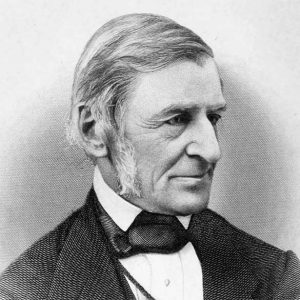Gary Ricketts
Ralph Waldo Emerson inherited his father’s affinity for Hinduism and lived long enough to convey its importance to Western spirituality during the first generation of American scholars to have some access to Hindu scriptures: As Robert C. Gordon notes, “Reverend Emerson founded the Anthology Club in 1804, and its members often discussed Indian themes. At about the same time, he became editor of the Monthly Anthology and Boston Review, a periodical which carried a number of articles on Indian philosophy and history during the years of Ralph Waldo’s childhood.” Written in the wake of Bleeding Kansas and in the same year of the Sumner attack, the Pottawatomie Massacre, Indian Wars, and the 1856 election, Ralph Waldo Emerson’s “Brahma” looks to the East for answers to the enigma of a polarized America just before the Civil War. (T.S. Eliot will similarly do so on a massive level with the “The Wasteland” in 1922.) The opening evokes Krishna and “The Bhagavad Gita”:
If the red slayer think he slays,
Or if the slain think he is slain,
They know not well the subtle ways
I keep, and pass, and turn again. (CW IX: 365)
The poem is stylized in the English tradition using iambic tetrameter—with inversions—but the content is purely Hindu. The speaker of the poem is Brahma (the Hindu creator god), but “the red slayer” is Krishna (an avatar of the preserver god Vishnu) who is of the warrior caste (Kshatriyas). Be it slayer or slain, all happenings are attributed to Brahma. Krishna stars as the chariot driver in “The Bhagavad Gita,” a popular section of the “Mahabharata” that is typically anthologized to explain the Hindu soul. Emerson called “The Gita” “the voice of an old intelligence which in another age & climate had pondered & thus disposed of the same questions which exercise us” (JMN X: 360). Krishna doubles as chariot driver and mentor to Arjuna (the protagonist of the Mahabharata) who is a reluctant warrior in the Kurukshetra War, the battle between the Pandavas and the Kauravas—two sides of a family split in war over land, drawing parallels to the schisms in American culture and ultimately the Civil War.
Arjuna’s reluctance to fight in the war, not out of fear but sympathy for the slain, is the catalyst for Krishna’s advice about metaphysics: the physical body, the Atman (reoccurring soul), karma-yoga and self-realization. Emerson appears to have taken his verse directly from Krishna’s directives: “The one who thinks that the Spirit is a slayer, and the one who thinks the Spirit is slain, both are ignorant. Because the Spirit neither slays nor is slain” (2.19). The eternal and omnipotent powers of Brahma or Krishna in “The Gita” reflect a comfortable, governing and deterministic power that pervades all. The New England Calvinist can say all happenings are the result of God’s will and rationalize any catastrophe through Biblical works like Job that deliver comfort: God punishes those he loves best, and it is best for those who suffer to avoid questioning his will. Albeit scientifically irrational, such a view allows one to find meaning amidst chaos but not for the scholarly Concord elite of the 1850s. In the 18th century, the fundamentalist way of interpreting the world as biblical exegesis was then replaced by the Enlightenment’s rational, mechanist, Newtonian method, which by its own precepts could not explain Emerson’s concern with fundamentals like “language, sleep, madness, dreams, beasts, sex” (CW I: 8).
Emerson’s work, as exemplified in “Brahma,” is a metonym for the romantic quest to uncover truth by looking into the past or the exotic as a restorative anchor in the face of the changing times. How can reason explain slavery, the Civil War and the failures of American idealism? By 1856 Emerson had lost his son, his marriage was unfulfilled and his career had seen its better years. When English and German Romantics looked to the past to escape the changing times, they had hundreds of years of folklore and literary tradition. Emerson did not; he resurrected spirituality from the confines of empiricism by turning eastward toward a mystical and literary culture, one accustomed to war and spirituality. The metaphor of war can readily be applied to any individual bound to inescapable personal conflict. “The Bhagavad Gita” reads like therapy and rightfully so: Arjuna is in need of Krishna’s wisdom because he cannot make sense of the horrors he will face in battle; just as Emerson’s evocation of the East is a way for him to make sense of his personal and nation strife. Krishna’s response includes duty on a personal level and an explanation of the whole cosmology of the universe: All is Brahman and everything is sanctioned.
Works Cited
Emerson, Ralph Waldo. “Brahma.” The Collected Works of Ralph Waldo Emerson, edited by
Albert J. von Frank and Thomas Worthham, vol. IX, Harvard University Press, 2011.
—. The Journals and Miscellaneous Notebooks of Ralph Waldo Emerson, edited by William H.
Gilman et al., 16 vols., Harvard University Press, 1960-1982.
—. Nature. The Collected Works of Ralph Waldo Emerson, edited by Alfred R. Ferguson, vol. I,
Harvard University Press, 1971.
Gordon, Robert C. “Emerson’s Interest in India.” Infinity Foundation,
https://www.infinityfoundation.com/mandala/i_es/i_es_gordo_emerson_frameset.htm.
Accessed 12 October 2020.
Mukundananda, Swami. Chapter 12, Verse 2, Bhagavad Gita: The Song of God
https://www.holy-bhagavad-gita.org/chapter/12/verse/2. Accessed 12 October 2020.
[Return to the Transparent Eyeball]
How to cite this post
Gary Ricketts. “’Brahma’ Contains Multitudes: Hinduism’s Influence on Emerson.” The Transparent Eyeball, First Series, The Ralph Waldo Emerson Society, Nov. 9, 2020, emersonsociety.org/the-transparent-eyeball/brahma-contains-multitudes-hinduisms-influence-on-emerson/. Accessed [date of access; ex. 5 Aug. 2021].
Ricketts, G. (2020, Nov. 9). “Brahma” Contains Multitudes: Hinduism’s Influence on Emerson. The Transparent Eyeball. https://emersonsociety.org/the-transparent-eyeball/brahma-contains-multitudes-hinduisms-influence-on-emerson/.
Ricketts, Gary. “’Brahma’ Contains Multitudes: Hinduism’s Influence on Emerson,” The Ralph Waldo Emerson Society. The Transparent Eyeball, Nov. 9, 2020, https://emersonsociety.org/the-transparent-eyeball/brahma-contains-multitudes-hinduisms-influence-on-emerson/.
